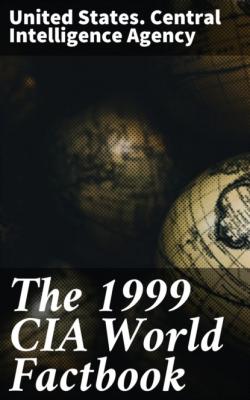The 1999 CIA World Factbook. United States. Central Intelligence Agency
Чтение книги онлайн.
Читать онлайн книгу The 1999 CIA World Factbook - United States. Central Intelligence Agency страница 16
 Puke, Sarande, Shkoder, Skrapar (Corovode),
Puke, Sarande, Shkoder, Skrapar (Corovode),Tepelene, Tirane (Tirana), Tirane* (Tirana), Tropoje (Bajram Curri),
Vlore
note: administrative divisions have the same names as their
administrative centers (exceptions have the administrative center
name following in parentheses)
Independence: 28 November 1912 (from Ottoman Empire)
National holiday: Independence Day, 28 November (1912)
Constitution: a new constitution was adopted by popular referendum on 28 November 1998; note—the opposition Democratic Party boycotted the vote
Legal system: has not accepted compulsory ICJ jurisdiction
Suffrage: 18 years of age; universal and compulsory
Executive branch:
chief of state: President of the Republic Rexhep MEIDANI (since 24
July 1997)
head of government: Prime Minister Pandeli MAJKO (since 2 October
1998)
cabinet: Council of Ministers nominated by the prime minister and
approved by the president
elections: president elected by the People's Assembly for a
five-year term; election last held 24 July 1997 (next to be held NA
2002); prime minister appointed by the president
election results: Rexhep MEIDANI elected president; People's
Assembly vote by number—total votes 122, for 110, against 3,
abstained 2, invalid 7
Legislative branch: unicameral People's Assembly or Kuvendi Popullor (155 seats; most members are elected by direct popular vote and some by proportional vote for four-year terms) elections: last held 29 June 1997 (next to be held NA 2001) election results: percent of vote by party—PS 53.36%, PD 25.33%, PSD 2.5%, PBDNJ 2.78%, PBK 2.36%, PAD 2.85%, PR 2.25%, PLL 3.09%, PDK 1.00%, PBSD 0.84%; seats by party—PS 101, PD 27, PSD 8, PBDNJ 4, PBK 3, PAD 2, PR 2, PLL 2, PDK 1, PBSD 1, PUK 1, independents 3
Judicial branch: Supreme Court, chairman of the Supreme Court is elected by the People's Assembly for a four-year term
Political parties and leaders: Albanian Socialist Party or PS
International organization participation: BSEC, CCC, CE, CEI,
EAPC, EBRD, ECE, EU (applicant), FAO, IAEA, IBRD, ICAO, ICRM, IDA,
IDB, IFAD, IFC, IFRCS, ILO, IMF, IMO, Intelsat (nonsignatory user),
Interpol, IOC, IOM, ISO, ITU, OIC, OPCW, OSCE, PFP, UN, UNCTAD,
UNESCO, UNIDO, UNOMIG, UPU, WFTU, WHO, WIPO, WMO, WToO, WTrO
(applicant)
Diplomatic representation in the US: chief of mission: Ambassador Petrit BUSHATI chancery: 2100 S Street NW, Washington, DC 20008
Diplomatic representation from the US: chief of mission: Ambassador Marisa R. LINO embassy: Rruga Elbasanit 103, Tirana mailing address: American Embassy, Tirana, Department of State, Washington, DC 20521–9510
Flag description: red with a black two-headed eagle in the center
Economy
Economy—overview: An extremely poor country by European standards, Albania is making the difficult transition to a more open-market economy. The economy rebounded in 1993–95 after a severe depression accompanying the collapse of the previous centrally planned system in 1990 and 1991. However, a weakening of government resolve to maintain stabilization policies in the election year of 1996 contributed to renewal of inflationary pressures, spurred by the budget deficit which exceeded 12%. The collapse of financial pyramid schemes in early 1997—which had attracted deposits from a substantial portion of Albania's population—triggered severe social unrest which led to more than 1,500 deaths, widespread destruction of property, and an 8% drop in GDP. The new government installed in July 1997 has taken strong measures to restore public order and to revive economic activity and trade. The economy continues to be bolstered by remittances of some 20% of the labor force which works abroad, mostly in Greece and Italy. These remittances supplement GDP and help offset the large foreign trade deficit. Most agricultural land was privatized in 1992, substantially improving peasant incomes. In 1998, Albania probably recovered most if not all of the 7% drop in GDP of 1997.
GDP: purchasing power parity—$5 billion (1998 est.)
GDP—real growth rate: 7% (1998 est.)
GDP—per capita: purchasing power parity?$1,490 (1998 est.)
GDP—composition by sector: agriculture: 56% industry: 21% services: 23% (1997)
Population below poverty line: 19.6% (1996 est.)
Household income or consumption by percentage share:
lowest 10%: NA%
highest 10%: NA%
Inflation rate (consumer prices): 40% (1997 est.)
Labor force: 1.692 million (1994 est.) (including 352,000 emigrant workers and 261,000 domestically unemployed)
Labor force—by occupation: agriculture (nearly all private; but some state employed) 49.5%, private business sector 22.2%, state business sector 28.3% (including state-owned industry 7.8%); note—includes only those domestically employed
Unemployment rate: 14% (October 1997) officially, but likely to
be as high as 28%
Budget:
revenues: $624 million
expenditures: $996 million, including capital expenditures of $NA
Industries: food processing, textiles and clothing; lumber, oil,
cement, chemicals, mining, basic metals, hydropower
Industrial production growth rate: 6% (1995 est.)
Electricity—production: 5.12 billion kWh (1996)
Electricity—production by source: fossil fuel: 4.3% hydro: 95.7% nuclear: 0% other: 0% (1996)
Electricity—consumption: 5.27 billion kWh (1996)
Electricity—exports: 0 kWh (1996) (1996)
Electricity—imports: 150 million kWh (1996)
Agriculture—products: wide range of temperate-zone crops and livestock
Exports: $212 million (f.o.b., 1998 est.)
Exports—commodities: asphalt, metals and metallic